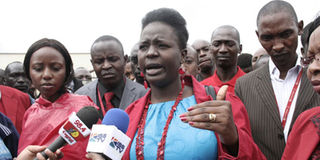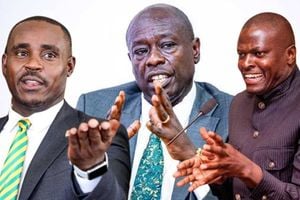Probe KQ deal, House team says

PHOTO | FILE Aviation and Allied Workers Union chairperson Perpetua Mponjiwa addresses journalists at the Kenya Airways headquarters after the Industrial Court ordered the 545 retrenched staff be reinstated.
What you need to know:
- In a report tabled in Parliament on Thursday afternoon, the Labour and Social Welfare Committee also attributed the airline’s precarious financial position to “mismanagement, corruption and negligence”
- Amboseli Ltd and Samburu Ltd are registered in the Cayman Islands and had at the end of September been used to acquire planes worth Sh5.3 billion
- Kenya Airways says the companies “have been incorporated by the airline’s lenders – Standard Chartered Bank and African Export Import Bank – as part of a financing arrangement in order to facilitate purchase of 10 new Embraer ERJ-190 aircraft from Embraer S.A., South America.”
The government should investigate the relationship between Kenya Airways and two companies registered in the Cayman Islands, a parliamentary committee has said.
In a report tabled in Parliament on Thursday afternoon, the Labour and Social Welfare Committee also attributed the airline’s precarious financial position to “mismanagement, corruption and negligence”. (Read: Kenya Airways reports Sh4.7bn loss due to huge costs)
The parliamentary committee, like the Industrial Court last Monday, says the 447 employees retrenched in September should be reinstated “with full benefits, unconditionally and without any victimisation”. (Read: KQ starts rehiring sacked staff)
“The Kenya Airways Board of directors and the government should immediately institute investigations into the mismanagement, corruption, negligence and alleged sexual harassments within the airline’s management and take requisite action to safeguard the interest of the shareholders and ensure investor confidence,” said the committee chaired by nominated MP Sophia Abdi Noor.
They also want the relationship between KQ and two offshore companies – Amboseli Ltd and Samburu Ltd – investigated “to safeguard the interest of shareholders an ensure investor confidence”.
Amboseli Ltd and Samburu Ltd are registered in the Cayman Islands and had at the end of September been used to acquire planes worth Sh5.3 billion.
This represents 6.85 per cent of Kenya Airways’ Sh77.43 billion assets.
Kenya Airways says the companies “have been incorporated by the airline’s lenders – Standard Chartered Bank and African Export Import Bank – as part of a financing arrangement in order to facilitate purchase of 10 new Embraer ERJ-190 aircraft from Embraer S.A., South America.”
“The two companies will be the transitory owners of the brand new aircraft currently being purchased by Kenya Airways until the loans are fully paid,” managing director Titus Naikuni said in a statement on November 13.
The committee states that “irregular outsourcing practices within the company have been a major avenue through which funds are lost and the two entities…were questionable.”
The committee’s investigations into the affairs of the national carrier started after 74 employees who are also members of the Aviation and Allied Workers Union petitioned Parliament to have them reinstated and KQ stopped from firing more workers.
Kenya Airways declared the employees redundant on the grounds that it was reducing an unsustainable wage bill.
But “the management was not candid”, the committee says.
“It recruited for some of the positions the retrenched workers had left and is still creating new senior management positions and recruiting to fill them,” says the committee, and “also went ahead to increase the salaries of its top management by 24 per cent”.
“The real challenges facing the airline include not just the wage bill but mainly downturn in passenger volumes…, an increasingly competitive environment, very high direct operating costs and other overheads which have continued to rise disproportionately to rise in revenues,” says the committee.
“It is worth noting that the airline under the same management has carried out several retrenchment exercises in the past but still finds itself in the sad state of affairs.”
The committee asks the Kenya Airways management to “stop victimising staff on the basis of gender and health status.”
“It should stop victimising Kenya Aviation and Allied Workers Union officials.”
Parliament has also asked for investigations into the Immigration ministry and the Kenya Civil Aviation Authority to establish whether work permits and crew certificates issued to foreigners were done within the law.
The committee has also directed the ministry and the aviation regulatory body to stop the issuance of permits to foreign workers for jobs where there are sufficient skills locally.
The committee said “Kenya Airways should have regard for its workers’ constitutional rights and fundamental freedoms relating to labour relations.”
“The airline should respect employees’ rights to fair labour practices in line with provision of Article 41 of the Kenya Constitution.”
It says most of the employees who were shown the door were sent text messages while on sick leave, maternity leave, in hospitals, or on duty out of their stations, which they deemed extremely cruel and barbaric.
“One employee had a premature birth as a result of emotional and psychological trauma while others developed complications despite having no recorded complications or conditions early on.”
The committee says the retrenchment was carried out in a hurry and even those who did not opt for voluntary early retirement were laid off and letters sent to them indicating they opted for retrenchment.
Before getting a court order temporarily stopping the retrenchment, the reports says, Kenya Airways sent text messages to employees saying they would undergo aptitude tests to identify those to leave.
“The company had begun the tests and had covered about five per cent of the entire workforce. When the court order was lifted, the company never concluded the testing and went ahead to hurriedly lay off even those who had not gone through the tests,” the reports states.
It says there was a deliberate objective to target women who had been on maternity leave in the last two years, those who were expectant and those who were unwell, including work related injuries and occupational health issues.
Others who were victimised included union officials, shop stewards as well as those who had actively participated in the 2009 strike.




